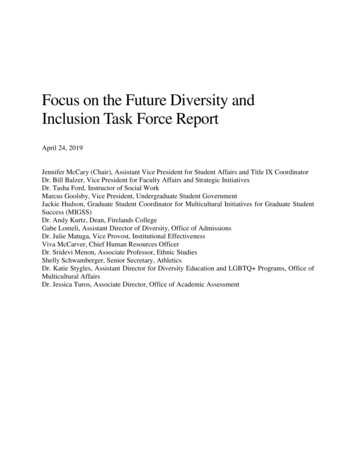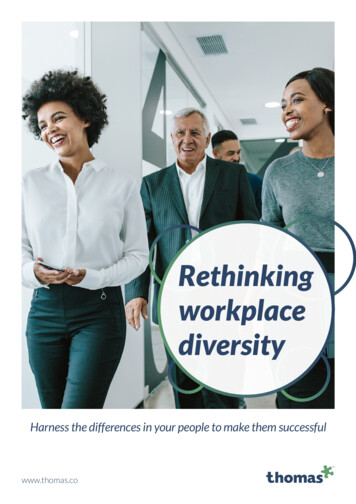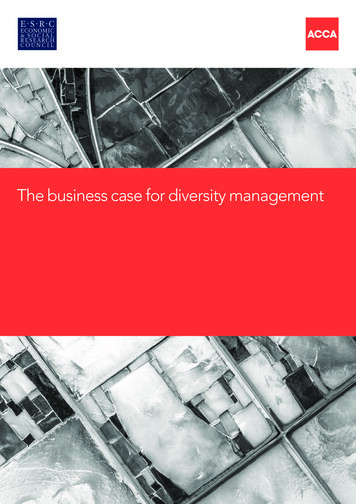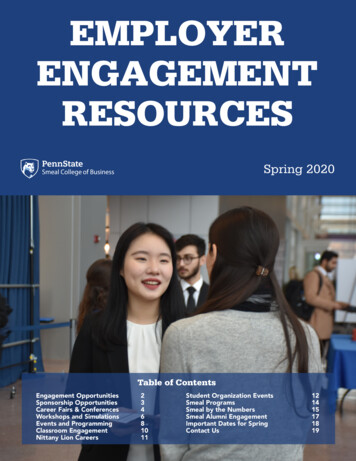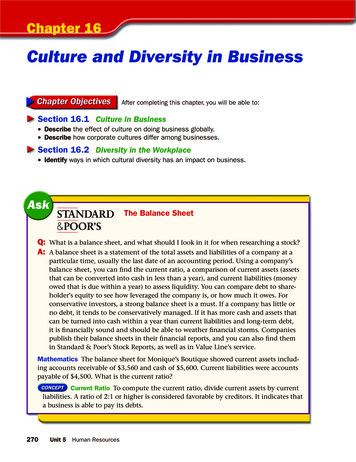
Transcription
Chapter 16Culture and Diversity in BusinessAfter completing this chapter, you will be able to:Section 16.1 Culture in Business Describe the effect of culture on doing business globally. Describe how corporate cultures differ among businesses.Section 16.2 Diversity in the Workplace Identify ways in which cultural diversity has an impact on business.AskQ:A:The Balance SheetWhat is a balance sheet, and what should I look in it for when researching a stock?A balance sheet is a statement of the total assets and liabilities of a company at aparticular time, usually the last date of an accounting period. Using a company’sbalance sheet, you can find the current ratio, a comparison of current assets (assetsthat can be converted into cash in less than a year), and current liabilities (moneyowed that is due within a year) to assess liquidity. You can compare debt to shareholder’s equity to see how leveraged the company is, or how much it owes. Forconservative investors, a strong balance sheet is a must. If a company has little orno debt, it tends to be conservatively managed. If it has more cash and assets thatcan be turned into cash within a year than current liabilities and long-term debt,it is financially sound and should be able to weather financial storms. Companiespublish their balance sheets in their financial reports, and you can also find themin Standard & Poor’s Stock Reports, as well as in Value Line’s service.Mathematics The balance sheet for Monique’s Boutique showed current assets including accounts receivable of 3,560 and cash of 5,600. Current liabilities were accountspayable of 4,500. What is the current ratio?Current Ratio To compute the current ratio, divide current assets by currentliabilities. A ratio of 2:1 or higher is considered favorable by creditors. It indicates thata business is able to pay its debts.270Unit 5Human Resources
Shared Values Many companies promotea strong corporate culture. Why might it beimportant for employees in a company toshare values, beliefs, and goals?Chapter 16 Culture and Diversity in Business271PhotoPhotoCredit:Credit:Jose vlkjdf;lkjeijeojf;ldkjl;dskfj;Luis Pelaez, Inc./Corbis
Section 16.1Culture in BusinessThink about what makes up a company’s culture and how differentcultures can impact a business.Read to Learn Describe the effect of culture on doingbusiness globally. Describe how corporate cultures differamong businesses.The Main IdeaA company’s culture is its shared values,beliefs, and goals that affect the way itsmanagement and employees interact. It alsoimpacts the way it works with people in othercountries with which it does business.Key Concepts Culture in a Global Economy Corporate CultureAcademic VocabularyYou will find these words in your reading andon your tests. Make sure you know theirmeanings.distinctethnicregiontraditionGraphic OrganizerList some attributes of a formal culture and aninformal culture in a figure like the one below.Corporate CultureFormalInformalVocabularyKey Termsculturebusiness etiquettecorporate culturehierarchybureaucracyGo to the Introduction to Business OnlineLearning Center through glencoe.com fora printable graphic organizer.Academic StandardsEnglish Language ArtsNCTE 1 Read texts to acquire new informationNCTE 9 Develop an understanding of diversity in language use across culturesMathematicsNumber and Operations Understand numbers, ways of representing numbers, relationships amongnumbers, and number systems272Chapter 16 Culture and Diversity in Businessglencoe.com
Culture in a Global EconomyThe word “culture” can have several different meanings.In general, culture is the beliefs, customs, and attitudes of adistinct group of people. A group’s culture is often consideredin terms of its dress, food, language, and art. It can also be considered in terms of a group’s history, geography, and religiousbeliefs. Culture can refer to an entire country or ethnic group.It can also refer to a specific social group or institution.The global economy creates a diverse culture for business. Ascompanies trade worldwide, they must be aware of different cultural and business practices. Each country has its own rules foretiquette, business customs, and personal interaction. Properlyapproaching people from various cultures can give them a betterimpression of you.In business, culture has two important meanings. In the broadsense, it refers to the customs of other countries with which companies do business. A custom is a practice followed by people ofa particular group or region. Business culture refers to the standards of a particular company. Companies that conduct businessin other countries must be aware of differences in laws, currencies, eating habits, and even systems of measurement. Failure tounderstand the culture of a country with which you do businesscan ruin a deal or lead to a marketing disaster.Think aboutthe benefits ofunderstanding othercultures.Identify What factors make up a group’s culture?Work EnvironmentDifferent workenvironments reflectvarious types of corporateculture. How would youdescribe the culture ofthis workplace?Section 16.1 Culture in Business273Photo Credit: Masterfile Royalty Free (RF)
Customer ServiceToday you can find a McDonald’s restaurant on every continent except Antarctica. Appealing to local tastes in some markets is an important way McDonald’s has grown globally. In Uruguay you can ordera “McHuevo,” a hamburger with a poached egg on top. Norwegianscan order a “McLaks,” a grilled salmon sandwich with dill sauce; andwhen you’re in Thailand, you can try the “Samurai Pork Burger,” a sausage patty in teriyaki sauce. Because personal service is so important to customers in the Middle East and Southeast Asia, McDonald’seven delivers there.Examples of Languages Across CulturesQ: In Bahasa-Indonesian, how do you say: “Goodbye”?A: Selamat tinggal (pronounced: Slă-măt tēng-gŭll)If you could add a local twist to a fast-food menu or restaurant in yourarea, what would it be?Marketing AbroadTo market products successfully in another country, companiesmust research the country’s languages, customs, and tastes. Forexample, when Pillsbury translated “Jolly Green Giant” intoArabic, the phrase became “Intimidating Green Ogre.” Soft-drinkmaker Coca-Cola changes the amount of carbonation and sugarin its products to suit the tastes of different countries.Doing Business AbroadThink aboutmarketing goodsin other countries.What are someobstacles you mightface?Companies doing business in other countries must be awareof cultural differences that affect the workplace. When the WaltDisney Company opened Euro Disney, French workers objectedto certain practices that were typical at Disney’s U.S. themeparks. As a result, 3,000 workers quit.Business EtiquetteBusiness etiquette is conduct that is considered socially acceptable in business. It differs from country to country. For example,in the United States, receiving a gift from a potential businesspartner could be seen as a bribe. In Japan, it is customary to givegifts, and there are many rituals involved. Before doing businessin India, it is customary to have tea. In Mexico, throwing documents on a table during a meeting is considered an insult.Many companies avoid cultural problems by hiring local managers in other countries. Some also prepare their own managersto live and work abroad. As more companies trade globally, thereis an increased demand for people who have studied other languages and cultures.274Chapter 16 Culture and Diversity in Business
Corporate CultureA company’s corporate culture is its shared values, beliefs,and goals. It can be defined formally through a company codeof ethics, a written manual, and the orientation process. It canalso be defined informally through dress codes, work habits, andsocial activities. The culture at McDonald’s, for example, stressescustomer service and family values. Employees are expected to beclean-cut and greet each customer with a smile. FedEx Kinko’sSM,Ben & Jerry’s , and Patagonia stress worker satisfaction and concern for the environment.A company’s founder can influence its culture. For instance,William Hewlett of computer-maker Hewlett-Packard stresseda “people first” culture. Region and tradition can also play bigparts. A banker at a Wall Street firm in New York may be expectedto wear a suit and tie. At a high-tech company in California’s Silicon Valley, workers might wear T-shirts and shorts to work.Contrast What other differences might youencounter if you worked at a Wall Street firmor a Silicon Valley company?Reader and Case StudyFashion, with a ConscienceCEO George Zimmer’s central tenet at Men’sWearhouse? “You’ve got to have a companythat starts with trust and fairness.”As founder and CEO of Men’s Wearhouse ,George Zimmer is known to the shopping publicas the bearded company pitchman who declares“I guarantee it!” in his TV commercials hawkingsuits and sport coats.Founded in 1973, the Men’s Wearhousechain has grown to more than 500 stores catering to the man who doesn’t necessarily adoreshopping. Stores are located in outdoor shopping centers, letting customers get in and outquickly. The 250 to 300 price tag for mostMen’s Wearhouse suits is budget-conscious.The merchandise isn’t high fashion, but it ispractical and functional.Behind the scenes, Zimmer has long workedto build a corporate culture that centers firstglencoe.comand foremost on keeping his employees happyand loyal. That culture appears to benefit Men’sWearhouse: So far this year, its shares haverisen 25%, outperforming the 1% increase in theStandard & Poor’s index of apparel retailers.CASE STUDY Go to the Introduction toBusiness Online Learning Center throughglencoe.com for the BusinessWeek ReaderCase Study.Active LearningTeam up with a classmate and go shoppingonline or in person for business appropriateclothing. Try on at least one suit. How does itmake you feel to be formally dressed? Writean advice column for your school newspaperthat gives suggestions on how to best presentan appropriate business image.Section 16.1Culture in Business275
Formal CultureThink about workingat a company with aformal culture. Whydo some companiesprefer this type oforganization?A company’s culture affects the way it is organized and doesbusiness. A formal business culture may have a strict hierarchy,or chain of command. A hierarchy usually has one person at thetop who makes all the decisions. There might be several levelsof management below. This is known as a bureaucracy. In formal cultures, making changes or passing down decisions can becomplicated. Job titles are indicators of power and status within acompany. Dress codes and work hours are strictly enforced.Informal CultureAt a company with an informal culture, employees are encouraged to make decisions on their own. They are allowed to dresscasually and have more flexible work hours. In some cases theycan even work at home. Job titles are not as important as creativity and teamwork. At computer memory maker KingstonTechnology , the founders sit in cubicles so they can interactwith employees and be available to them. Few companies have aculture that is entirely formal or informal. Within one companythere are often different cultures.Section 16.1Review Key Concepts1. Why should businesses involved in global trade be aware of cultural differences?2. How is a company’s corporate culture defined?3. What are some characteristics of a formal corporate culture?Academic Skills4. Mathematics Monica was traveling toEngland and France on business. Sheflew from London to Paris and wanted toexchange some U.S. dollars (USD) andBritish pounds (GBP) into euros (EUR).She went to the exchange bank and sawthis sign:CurrencySellBuyGBP1.46990 EUR0.68032 EURUSD0.83399 EUR1.19962 EURCompare the values of a single dollar,euro, and pound by writing an expression that orders them from least togreatest.Inequalities Use the symbol to mean greater than and to mean lessthan.For math help, go to theMath Appendix.Go to the Introduction to Business Online Learning Center throughglencoe.com to check your answers.276Chapter 16 Culture and Diversity in Businessglencoe.com
Section 16.2Diversity in the WorkplaceThink about how cultural diversity can help a company becomesuccessful.Read to LearnGraphic Organizer Identify ways in which cultural diversity hasAs you read, list the benefits of diversity in afigure like the one below.an impact on business.The Main IdeaCompanies are more aware of the growingspending power of different consumer groups.Human resources managers find ways to drawon the strengths of culturally diverse workers.Key Concept Cultural DiversityVocabularyKey Termsdiversitydiscriminationstereotypeageismbaby boom generationAcademic VocabularyYou will find these words in your reading andon your tests. Make sure you know tionBenefits ofDiversityGo to the Introduction to Business OnlineLearning Center through glencoe.com fora printable graphic organizer.Academic StandardsEnglish Language ArtsNCTE 1 Read texts to acquire new informationNCTE 1 Use written language to communicate effectivelyNCTE 9 Develop an understanding of diversity in language use across culturesNCTE 12 Use language to accomplish individual purposesScienceContent Standard F Students should develop an understanding of personal and community healthand science and technology in local, national, and global challengesglencoe.comSection 16.2 Diversity in the Workplace277
Cultural DiversityThink about thegrowth of theU.S. population.What effects doyou think that theincreasingly diversepopulation will haveon business in thefuture?Companies tend to thrive when they have diversity, a varietyof employees with different backgrounds and identities. Peopleare diverse in terms of age, gender, ethnicity, and individualneeds. They also differ in terms of education, marital status,income, and religious beliefs. Diversity in the workplace meansdifferences in skills, work habits, and approaches to tasks. Peoplewith the same assignments will carry them out in different ways.Some people stereotype others who are different from them.To stereotype people is to identify them by a single trait or as amember of a certain group rather than as individuals. In fact, notwo people are alike. Your success on the job will depend on howwell you work with and for people who are different from you.Identify What are some ways in which people arediverse?The Impact of Diversity on BusinessThe U.S. population is becoming more ethnically diverse.Each year, more than 1 million people come to the United Statesfrom all over the world. As total population grows, the percentages of people with African, Asian, and Hispanic or LatinoAdaptive TechnologiesHiring people with physical disabilities and accommodating theirspecial workplace needs is easier than ever, thanks to the development of adaptive technologies. For example, voice recognition software transforms the human voice using a computer input devicethat can replace the mouse and keyboard, and improves the productivity of people with movement problems. Unique authoring toolsnow enable Web designers to incorporate sign language into theirWeb sites to assist those with hearing impairment. Improvementsin videoconferencing technologies are making telecommuting areality for many who couldn’t enter the workplace any other way.Fully incorporating employees with these kinds of special needsincreases workplace diversity and impacts corporate culture.Go to the Introduction to Business Online Learning Center throughglencoe.com for links to Web sites where you can find out moreabout adaptive technologies and how they help people and companies reach their potential. Research the stories of individuals whouse adaptive technologies in their daily work lives. Write a few paragraphs about how adaptive technologies are changing the diversityof the workplace.278Chapter 16 Culture and Diversity in Businessglencoe.com
heritage also grow. The fastest growing groups in the countryare people of Hispanic and Asian origins. These changes areexpected to continue. The growth of different cultures greatlyimpacts business.The population is also living longer. More workers aged 65and over are working past retirement age. They will account fora larger share of the U.S. labor force over the next several years.The growth rate for women in the labor force is expected to riseat a slightly faster rate than for men. Workers aged 25 to 54 arethe largest share of the workforce. (See Figure 16.1.)Changes in the Workplace As the population becomes morediverse, so does the workplace. There are greater numbers ofwomen, Asians, Hispanics, and African Americans in management positions. Many workers from various cultures meet peopleof different ages, ethnic backgrounds, and abilities for the firsttime when they enter the workplace.Think about someof your favoriteTV commercials.What groups weretargeted in theseads?Changes in the Marketplace A more diverse population alsomeans a more diverse marketplace. With more jobs, women andethnic groups have more spending power and a larger share ofthe market. Companies now target several market segments. Forexample, many companies run ads in both English and Spanishand tailor them to different ethnic groups. The 76 million babiesborn in the United States between 1946 and 1964 are called thebaby boom generation. Many members of this generation arereaching retirement age and developing specific needs.Figure 16.1Demographics of the Workforce The U.S. WorkforceThis pie chart shows theU.S. workforce by age ina recent year. Which agegroup has the largestnumber of workers?"HF "HF BOE PWFSSource: Bureau of Labor StatisticsSection 16.2Diversity in the Workplace279
Photo Credit: Corbis RFA Diverse Workplace The blending of people with different skillsand perspectives into the workplace can help businesses understandand react to an increasingly diverse population. How does a diverseworkforce aid a business in serving a diverse market?Managing DiversityHuman resources managers oversee diversity. They seek waysto make the company inclusive by hiring people of differentcharacteristics, backgrounds, and ethnicities. This diversity leadsto a more realistic world view, which can lead to a competitiveadvantage. Employee diversity is an asset in dealing with clientsand customers of various cultures. Diversity management programs try to draw on the strength of a company’s melting pot.Real WorldSeeking AllQualified WorkersMany companiesstate that they areequal opportunityemployers in theiremployment ads.Some also stress thatwomen and peoplewith disabilities areencouraged to applyfor jobs. Why do youthink companies dothis?280Laws Against Discrimination Discrimination is unfair treatment of a person or group, usually because of prejudiced attitudes about race, ethnicity, age, religion, or gender. Many lawshave been passed to prevent discrimination. For example, in thepast, workers over the age of 40 were often fired or denied jobsin favor of younger workers. This form of discrimination is calledageism. To protect older workers, the U.S. government passedthe Age Discrimination in Employment Act. It prohibits discrimination against workers because of their age.The Equal Employment Opportunity Act was passed tostrengthen laws that protect workers from discrimination basedon race, ethnicity, religion, or gender. Workers with specificneeds often could not work because buildings lacked properaccess or equipment. In 1990, the Americans with Disabilities Act(ADA) was passed. ADA prohibits discrimination against qualifiedpeople who have disabilities. Employers must make a reasonableaccommodation for a qualified person with a disability. Examples of reasonable accommodation include adjusting buildings sothat people in wheelchairs can move around them.Chapter 16 Culture and Diversity in Business
Diversity Prog
of management below. This is known as a bureaucracy. In for-mal cultures, making changes or passing down decisions can be complicated. Job titles are indicators of power and status within a company. Dress codes and work hours are strictly





